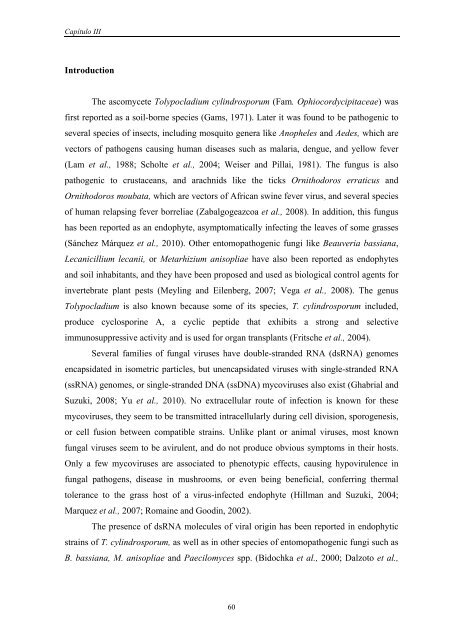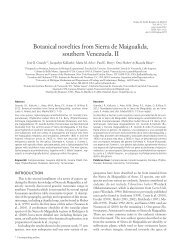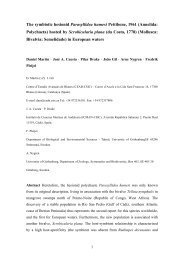TESIS NOEMI HERRERO.pdf - Consejo Superior de Investigaciones ...
TESIS NOEMI HERRERO.pdf - Consejo Superior de Investigaciones ...
TESIS NOEMI HERRERO.pdf - Consejo Superior de Investigaciones ...
Create successful ePaper yourself
Turn your PDF publications into a flip-book with our unique Google optimized e-Paper software.
Capítulo III<br />
Introduction<br />
The ascomycete Tolypocladium cylindrosporum (Fam. Ophiocordycipitaceae) was<br />
first reported as a soil-borne species (Gams, 1971). Later it was found to be pathogenic to<br />
several species of insects, including mosquito genera like Anopheles and Ae<strong>de</strong>s, which are<br />
vectors of pathogens causing human diseases such as malaria, <strong>de</strong>ngue, and yellow fever<br />
(Lam et al., 1988; Scholte et al., 2004; Weiser and Pillai, 1981). The fungus is also<br />
pathogenic to crustaceans, and arachnids like the ticks Ornithodoros erraticus and<br />
Ornithodoros moubata, which are vectors of African swine fever virus, and several species<br />
of human relapsing fever borreliae (Zabalgogeazcoa et al., 2008). In addition, this fungus<br />
has been reported as an endophyte, asymptomatically infecting the leaves of some grasses<br />
(Sánchez Márquez et al., 2010). Other entomopathogenic fungi like Beauveria bassiana,<br />
Lecanicillium lecanii, or Metarhizium anisopliae have also been reported as endophytes<br />
and soil inhabitants, and they have been proposed and used as biological control agents for<br />
invertebrate plant pests (Meyling and Eilenberg, 2007; Vega et al., 2008). The genus<br />
Tolypocladium is also known because some of its species, T. cylindrosporum inclu<strong>de</strong>d,<br />
produce cyclosporine A, a cyclic pepti<strong>de</strong> that exhibits a strong and selective<br />
immunosuppressive activity and is used for organ transplants (Fritsche et al., 2004).<br />
Several families of fungal viruses have double-stran<strong>de</strong>d RNA (dsRNA) genomes<br />
encapsidated in isometric particles, but unencapsidated viruses with single-stran<strong>de</strong>d RNA<br />
(ssRNA) genomes, or single-stran<strong>de</strong>d DNA (ssDNA) mycoviruses also exist (Ghabrial and<br />
Suzuki, 2008; Yu et al., 2010). No extracellular route of infection is known for these<br />
mycoviruses, they seem to be transmitted intracellularly during cell division, sporogenesis,<br />
or cell fusion between compatible strains. Unlike plant or animal viruses, most known<br />
fungal viruses seem to be avirulent, and do not produce obvious symptoms in their hosts.<br />
Only a few mycoviruses are associated to phenotypic effects, causing hypovirulence in<br />
fungal pathogens, disease in mushrooms, or even being beneficial, conferring thermal<br />
tolerance to the grass host of a virus-infected endophyte (Hillman and Suzuki, 2004;<br />
Marquez et al., 2007; Romaine and Goodin, 2002).<br />
The presence of dsRNA molecules of viral origin has been reported in endophytic<br />
strains of T. cylindrosporum, as well as in other species of entomopathogenic fungi such as<br />
B. bassiana, M. anisopliae and Paecilomyces spp. (Bidochka et al., 2000; Dalzoto et al.,<br />
60

















